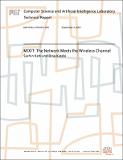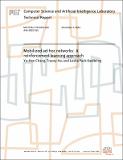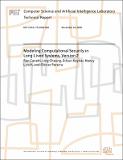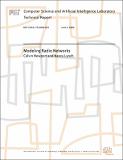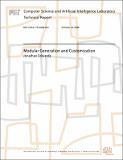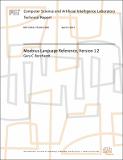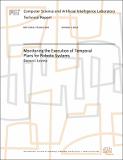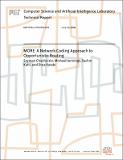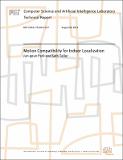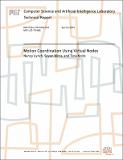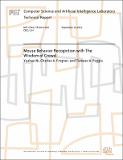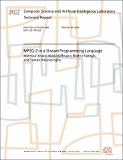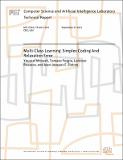Browsing CSAIL Digital Archive by Title
Now showing items 435-454 of 806
-
Methods and Experiments With Bounded Tree-width Markov Networks
(2004-12-30)Markov trees generalize naturally to bounded tree-width Markov networks, onwhich exact computations can still be done efficiently. However, learning themaximum likelihood Markov network with tree-width greater than 1 is ... -
Middleboxes No Longer Considered Harmful
(2004-06-24)Intermediate network elements, such as network address translators (NATs), firewalls, and transparent caches are now commonplace. The usual reaction in the network architecture community to these so-called middleboxes is ... -
MIXIT: The Network Meets the Wireless Channel
(2007-09-04)The traditional contract between the network and the lower layers states that the network does routing and the lower layers deliver correct packets. In a wireless network, however, different nodes may hear most bits in a ... -
Mobilized ad-hoc networks: A reinforcement learning approach
(2003-12-04)Research in mobile ad-hoc networks has focused on situations in whichnodes have no control over their movements. We investigate animportant but overlooked domain in which nodes do have controlover their movements. ... -
Modeling Computational Security in Long-Lived Systems, Version 2
(2008-11-22)For many cryptographic protocols, security relies on the assumption that adversarial entities have limited computational power. This type of security degrades progressively over the lifetime of a protocol. However, some ... -
Modeling Network User Behavior: Various Approaches
(2016-06-28)This project involves learning to predict users' mobility within the network topology. Topological mobility, as opposed to physical mobility, can be substantial as a user switches from LTE to wifi network, while moving ... -
Modeling Radio Networks
(2009-06-04)We describe a modeling framework and collection of foundational composition results for the study of probabilistic distributed algorithms in synchronous radio networks. Existing results in this setting rely on informal ... -
Modular Generation and Customization
(2008-10-10)Modularity and flexibility can conflict in multi-language systems. For example, the templates commonly used to generate web pages must be manually updated when the database schema changes. Modularity can be improved by ... -
Moebius Language Reference, Version 1.2
(2014-04-09)Moebius is a representation and interface language based on a subset of English. It is designed for use as a means of encoding information and as a means of conveying information between software components and other ... -
Monitoring the Execution of Temporal Plans for Robotic Systems
(2012-10-04)To achieve robustness in dynamic and uncertain environments, robotic systems must monitor the progress of their plans during execution. This thesis develops a plan executive called Pike that is capable of executing and ... -
MOOS-IvP Autonomy Tools Users Manual
(2008-11-11)This document describes seven common MOOS-IvP autonomy tools. The uHelmScope application provides a run-time scoping window into the state of an active IvP Helm executing its mission. The pMarineViewer application is a ... -
MOOS-IvP Autonomy Tools Users Manual
(2010-08-23)This document describes fifteen MOOS-IvP autonomy tools. uHelmScope provides a run-time scoping window into the state of an active IvP Helm executing its mission. pMarineViewer is a geo-based GUI tool for rendering marine ... -
MOOS-IvP Autonomy Tools Users Manual Release 4.2.1
(2011-07-28)This document describes 19 MOOS-IvP autonomy tools. uHelmScope provides a run-time scoping window into the state of an active IvP Helm executing its mission. pMarineViewer is a geo-based GUI tool for rendering marine ... -
MORE: A Network Coding Approach to Opportunistic Routing
(2006-06-30)Opportunistic routing has the potential to substantially increase wireless network throughput. Prior work on opportunistic routing, however, requires tight node coordination. Different nodes in a network must have knowledge ... -
Motion Compatibility for Indoor Localization
(2014-08-26)Indoor localization -- a device's ability to determine its location within an extended indoor environment -- is a fundamental enabling capability for mobile context-aware applications. Many proposed applications assume ... -
Motion Coordination Using Virtual Nodes
(2005-04-06)We describe how a virtual node abstraction layer can be used to coordinate the motion of real mobile nodes in a region of 2-space. In particular, we consider how nodes in a mobile ad hoc network can arrange themselves along ... -
Mouse Behavior Recognition with The Wisdom of Crowd
(2013-09-19)In this thesis, we designed and implemented a crowdsourcing system to annotatemouse behaviors in videos; this involves the development of a novel clip-based video labeling tools, that is more efficient than traditional ... -
MPEG-2 in a Stream Programming Language
(2005-10-22)Image and video codecs are prevalent in multimedia applications, ranging from embedded systems, to desktop computers, to high-end servers such as HDTV editing consoles. It is not uncommon however that developers create ... -
Multi-Class Learning: Simplex Coding And Relaxation Error
(2011-09-27)We study multi-category classification in the framework of computational learning theory. We show how a relaxation approach, which is commonly used in binary classification, can be generalized to the multi-class setting. ... -
Multi-modal and Inertial sensor Solutions for Navigation-type Factor Graphs
(MIT, 2017-08-31)This thesis presents a sum-product inference algorithm for platform navigation called Multi-modal iSAM (incremental smoothing and mapping). Common Gaussian only likelihoods are restrictive and require a complex front-end ...



